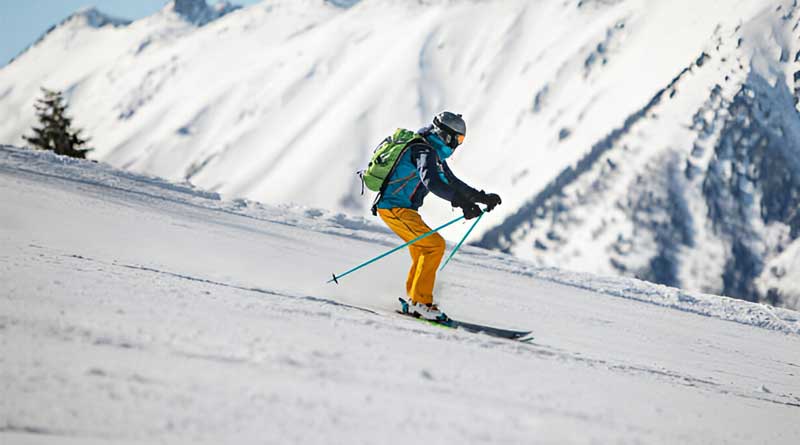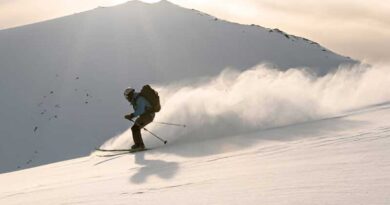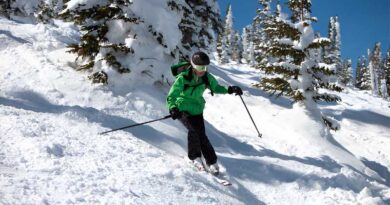-
Sidecut: Dual-Progressive Sidecut with tight radius at nose/tail and relaxed waist radius
-
Core: Full Poplar Wood Core for energetic and responsive flex
-
Rocker Type: Rocker/Camber/Rocker for versatility in mixed terrain
-
Tail Type: Full Twin Tip for playful, switch-friendly performance
The Season Primer is a superb all-mountain ski for beginners and intermediate riders who want to explore every corner of the resort. Designed by skiing legend Eric Pollard and snowboarder Austin Smith, it’s a tool that makes carving feel intuitive and progression fun. The dual-progressive sidecut is one of its standout features—tight up front and in the tail for easy turn initiation, but relaxed underfoot to keep things stable when speeds pick up. This encourages skiers to learn how to use their edges properly while also offering enough forgiveness to build confidence along the way. The Poplar wood core adds pop and life, delivering a ride that’s both playful and stable.
But the Primer isn’t just a beginner’s ski—it’s also a great choice for intermediate riders or more experienced skiers who want something forgiving, snappy, and versatile. Its full twin-tip shape makes switch skiing and park laps feel natural, while the mild taper and narrow waist widths provide quick edge-to-edge transitions and surprising float in soft snow. Whether you’re on groomers, dabbling in powder, or experimenting in the terrain park, the Season Primer is more than capable. It’s also backed by the Season Pass program from evo, which adds long-term value by supporting skiers to keep riding year after year.
Pros
- Easy to carve and turn, great for building confidence
- Versatile shape for all-mountain and freestyle use
- Lightweight and lively thanks to poplar wood core
- Designed with long-term durability and support in mind
Cons
- Doesn’t come with bindings
- May not offer enough stiffness for expert-level skiers at high speed
See the Season Primer
3. Atomic Bent 85

-
Core: Light Wood and Densolite hybrid core for balance of strength and lightweight feel
-
Rocker Type: All Mountain Rocker – 20% Tip / 65% Camber / 15% Tail
-
Sidewalls: Dura Cap Sidewall for power transmission and added durability
-
Bindings: Includes M 10 GW Bindings (DIN range 2–10), not pre-mounted
The Atomic Bent 85 is a versatile and durable all-mountain ski that delivers a playful ride for beginners and intermediates alike. Designed to handle everything from groomers to light park sessions, this ski shines with its All Mountain Rocker profile that makes turn initiation smooth and intuitive. The directional shape and hybrid wood/Densolite core help keep things light underfoot without sacrificing too much in terms of stability or control. Although originally built for the rental market, its beefed-up construction—like the Dura Cap Sidewall and thicker Resist Edges—actually adds appeal for everyday riders who want a ski that can take a beating and still keep going.
What makes the Bent 85 especially compelling is its freestyle-friendly edge. The partial twin tip lets you comfortably ride switch, and the durable edge design handles park abuse far better than most entry-level models. Sure, the hybrid core doesn’t quite match the flex or longevity of a full wood core, but that tradeoff helps keep the ski lightweight and affordable. Ideal for progressing riders who want to explore more of the mountain, from casual carving to playful laps in the park, the Bent 85 offers a well-rounded, value-packed setup. And with the included M 10 GW bindings, you’re getting a ready-to-ride package that won’t hold you back.
Pros
- Durable construction designed to handle heavy use
- Easy to maneuver at low and moderate speeds
- Good for park, groomers, and all-mountain exploration
- Includes bindings at an accessible price
Cons
- Hybrid core lacks some natural flex and longevity
- Doesn’t offer high-speed performance for advanced skiers
See the Atomic Bent 85
4. K2 Disruption 76

-
Core: Lightweight Composite Core for a soft, forgiving flex
-
Rocker Type: Catch Free Rocker – Gradual rise in tip and tail for easier turn initiation
-
Laminates: I-Beam Construction with full-length carbon for added stability and energy
-
Sidewalls: Hybritech Construction for lower swing weight and improved durability
The K2 Disruption 76 is a fantastic option for beginner to intermediate skiers looking to build confidence on groomed runs. Its Catch Free Rocker profile makes turn initiation feel natural and smooth, which is especially helpful at slower speeds. The composite core keeps the ski light and easy to handle, reducing fatigue during long sessions on the slopes. This ski is particularly effective in making tighter turns and navigating icier terrain, making it well-suited for skiers who are still developing their edge control. The included M2 10 Quikclik bindings offer easy setup and reliable performance, rounding out a very user-friendly package.
Built with I-Beam construction, the Disruption 76 brings just the right touch of energy and responsiveness without being overwhelming. The carbon layer adds some liveliness to the ride, helping the ski rebound through turns and maintain better stability. The Hybritech sidewalls provide a blend of edge grip and low swing weight, making the ski feel nimble and easy to pivot. While it may lack the stiffness and top-end performance for aggressive or expert skiers, its smooth, forgiving ride makes it perfect for progressing comfortably and confidently. Whether you’re just getting started or you’re a cautious carver seeking predictability on groomers, the K2 Disruption 76 is a worthy companion.
Pros
- Very forgiving and beginner-friendly ride
- Lightweight and easy to control
- Smooth turn initiation with Catch Free Rocker
- Great for tighter turns and icier conditions
Cons
- Not ideal for high-speed carving
- Lacks advanced-level performance and stiffness
See the K2 Disruption 76
5. Dynastar E-Cross 78 – Women’s

-
Core: Hybrid Core (Wood + PU) for balance of performance and lightness
-
Rocker Type: Directional Rocker (Rocker/Camber) for smooth initiation and control
-
Sidewalls: Sandwich Full Sidewall Construction for reliable edge grip
-
Base: Sintered HD Base for improved glide and durability
The Dynastar E-Cross 78 is a great ski for women looking to move beyond the rental game and invest in a pair that can grow with their skills. Designed with beginner to intermediate skiers in mind, it features a Directional Rocker that makes turn initiation feel easy and smooth, while still offering dependable grip when carving on hardpack. The hybrid wood and PU core gives the ski a lightweight, forgiving flex, but doesn’t sacrifice the energy and rebound needed for progression. It feels playful at low speeds and surprisingly stable when you start picking up the pace. Included XP 10 bindings provide a complete, ready-to-ride setup, with DIN settings that accommodate a wide range of skier weights and abilities.
What makes the E-Cross 78 stand out is its mix of confidence-building design and quality construction. The full sandwich sidewall enhances edge control and power transmission, which helps when transitioning from gentle greens to steeper blues. The Sintered HD base is a bonus at this level—it offers better glide than you’d expect in an entry-to-intermediate ski, keeping things fast and fun even in flatter sections. While it’s not built for high-speed charging or deep powder days, this ski is an excellent everyday resort companion for skiers who want reliable performance as they continue to improve.
Pros
- Easy to control and forgiving for beginners
- Strong edge grip for growing confidence on harder snow
- Lightweight hybrid core balances power and ease of use
- Comes with bindings, ready for setup
Cons
- Not ideal for advanced or aggressive skiing
- Limited float in deep snow
See the Dynastar E-Cross 78 – Women’s
How to Choose Skis as a Beginner?
Choosing your first pair of skis can feel overwhelming. With so many shapes, sizes, and technical terms thrown around, it’s hard to know what really matters when you’re just starting out. The good news? You don’t need the most expensive or advanced skis to enjoy the slopes—you just need something that’s comfortable, forgiving, and confidence-building. This guide breaks down everything beginners need to consider when choosing the right skis.
1. Know Your Skill Level and Goals
The first step in choosing the right skis is understanding where you are as a skier. If you’re completely new to skiing or still mastering your turns on green and blue runs, you fall into the “beginner” or “beginner-intermediate” category. Your ideal ski will help you develop good technique, make turning easier, and offer control at slower speeds.
Your goals matter too. Are you mostly skiing groomed resort trails? Do you eventually want to explore off-piste terrain or learn freestyle tricks? Knowing what kind of skiing interests you will help shape the type of ski you choose.
2. Ski Length: Shorter Is (Usually) Better
Ski length has a big impact on how easy a ski is to control. For beginners, shorter skis are easier to turn and maneuver, which is crucial while learning.
A good general rule: beginner skis should come up somewhere between your chin and nose when standing upright. If you’re on the lighter side or cautious on the slopes, go closer to chin height. If you’re more athletic or plan to ski more aggressively, you might go slightly longer.
Keep in mind, different skis have different shapes (like tip and tail rocker), which can affect how long a ski “feels” on the snow. Always refer to the manufacturer’s size chart as well.
3. Ski Width: Narrow Is More Nimble
Ski width is measured at the waist (the narrowest part of the ski). For beginners sticking to groomed trails, a narrower ski—around 70–85mm underfoot—is ideal. Narrow skis transition from edge to edge more easily, which makes turning simpler and more intuitive.
Wider skis (above 90mm) are meant for off-piste or powder skiing. They provide more float in soft snow but can feel clunky and hard to maneuver on hardpack—especially for new skiers.
4. Rocker Profile: Look for Rocker/Camber Combo
A ski’s rocker profile describes how it curves along its length. Most skis use a rocker/camber/rocker profile. This means:
This combination gives you the best of both worlds: easier turning with stability and edge control. Avoid full camber skis or those with aggressive shapes unless you’re being guided by a knowledgeable instructor or shop tech.
5. Flex and Construction: Softer = Forgiving
Flex refers to how stiff the ski is. Beginners should look for a softer flex because it’s more forgiving and doesn’t punish mistakes. Softer skis absorb bumps and make it easier to control speed and turns.
Most skis use composite or hybrid cores (wood + foam or polyurethane) to reduce weight and increase flexibility. While advanced skis might use layers of metal for power and speed, these materials can make skis too stiff and challenging for beginners.
6. Sidecut and Turning Radius: Short Is Sweet
The sidecut is the hourglass shape of a ski and affects its turning radius. Skis with more sidecut (wider tips and tails with a narrow waist) have a shorter turning radius and are better at making tighter turns.
Beginner skis generally have a short turning radius (10–15 meters), which makes learning parallel turns much easier. Avoid skis with long turning radii designed for high-speed carving—these are harder to control at slower speeds.
7. Bindings: Included Is Convenient
Most skis come as a package with bindings included. This is ideal for first-timers—it saves money, and the bindings are usually pre-selected to match the ski’s flex and design.
Look for bindings with a DIN range that starts around 2–3 and goes up to 10. This allows flexibility as you improve and gain confidence. Always have a certified technician mount and adjust your bindings based on your weight, height, boot size, and ability level.
8. Durability and Value: Rental-Ready Models Are Smart
Some skis are built with added durability for the rental market. While these might seem like lower-end options, they’re actually great for beginners—they’re tough, forgiving, and designed for repeated use.
Brands like Atomic (e.g., Bent 85 R), Dynastar (E-Cross series), K2 (Disruption 76), and Rossignol (Experience 78 CA) all offer beginner-friendly skis that balance performance with durability and ease of use.
9. Price: What Should You Spend?
You don’t need to break the bank to get a solid first pair of skis. Beginner packages (skis + bindings) typically cost between $400–$600. Anything cheaper may lack quality; anything more expensive might include features that are unnecessary for learning.
If you’re planning to ski just once or twice a season, renting may still be more cost-effective. But if you’re committed to skiing more regularly, buying your own skis is worth it in terms of comfort, fit, and convenience.
10. Demo If You Can
If you’re unsure what kind of ski you like, consider renting a few different models or attending a demo day at a resort. Trying skis before buying gives you a real-world feel for what works best for your style, body type, and terrain preference.
Final Thoughts
Choosing beginner skis doesn’t have to be complicated. Focus on models that offer easy turning, forgiving flex, and a comfortable ride. The best skis aren’t the flashiest or stiffest—they’re the ones that build your confidence and keep you having fun on the mountain.
Look for skis with:
-
Rocker/camber profiles for easier turning
-
Narrow waists (70–85mm) for quicker edge control
-
Soft flex and composite or hybrid cores for comfort
-
Short turning radius for learning proper carving technique
Stick with trusted brands, buy from a reputable retailer, and have your bindings mounted by a certified tech. With the right skis underfoot, your first season will be smoother, safer, and way more fun.









